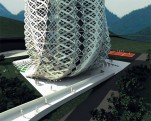Filigree of Guiyang

In the past 15 years, around 10 billion sqm of built space has been created in the urban areas of China. Within 20 years period, another 200 to 400 new cities will be built. Until now, the results of this overwhelming urbanization have been defined by high-density, highspeed and low-quality duplication.
Having in mind a new project, local architects have to challenge with rather sophisticated matters. Are they going to continue copying the skyline of Western cities created over a hundred years of industrial civilization? Will Manhattan and Chicago continue to be our model city, even after 15 years of urban construction in China? Is there an alternative future for Chinese cities that lies in the current social condition, where new technologies leave the machine age behind, and where the city increasingly invades the natural space?
To address these questions, in 2008, MAD invited 11 young international architects to design the Huaxi city centre of Guiyang, in South Western China. They were: Atelier Manferdini (USA), BIG (Denmark), Dieguez Fridman (Argentina), Emergent (USA), HLA (China), JDS (Denmark), MAD (China), MASS Studies (Korea), Rojkind Arquitectos (Mexico), SERIE (UK), Sou Fujimoto Architects (Japan).
Each architect provided a unique design for a single part of the masterplan, based on their own understanding and interpretation of the local natural and cultural elements. The result is a series of organic individual buildings, growing from the natural environment, and working together to produce a compound of diverse urban activities.
Based on an Eastern understanding of nature, this joint urban experiment aims to explore whether we can use new technologies and global ideas to reconnect the natural and man-made world.
The area of Huaxi is famous for its dramatic and beautiful landscape, as well as a diverse mix of minority cultural inhabitants during its history. Its future is defined by the local government’s urban planning as a new urban centre for finance, cultural activities and tourism. Each proposal provided a unique design for a single part of the master-plan, based on their own understanding and interpretation of the local natural and cultural elements.
In this high density urban environment, the limits of urbanization are controlled and set by nature; the buildings take on the dynamic topography of the site, touching the landscape in a more interactive way. Generic verticality is replaced by a complex taxonomy of urban activities, defined by a multiplicity of connections, detours and short cuts. The natural and the artificial are fused together, revealing an image of a future architecture.
The ecological method here is not just focused on saving energy; rather, the goal is to create a new, balanced urban atmosphere which can evoke the feeling of exploring the natural environment. The city is no longer determined by the leftover logic of the industrial revolution (speed, profit, efficiency) but instead follows the “fragile rules” of nature.
Full content of this issue you can read here
The full version of the article can be read in our printed issue, also you can subscribe to the web-version of the magazine
 Materials provided by Atelier Manferdini
Materials provided by Atelier Manferdini


